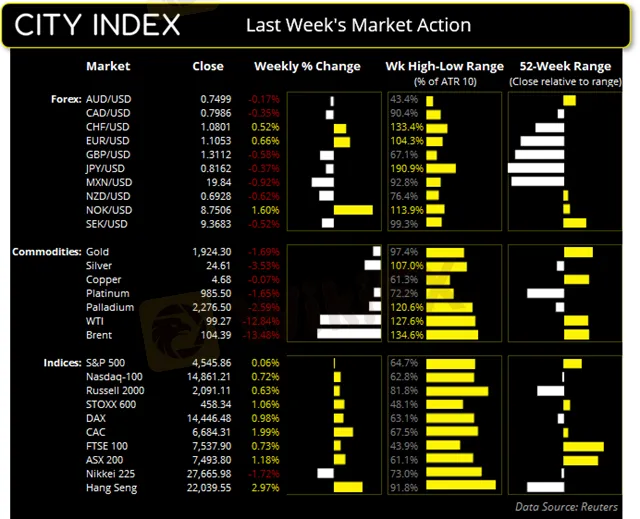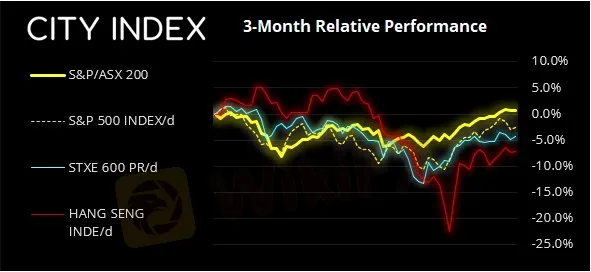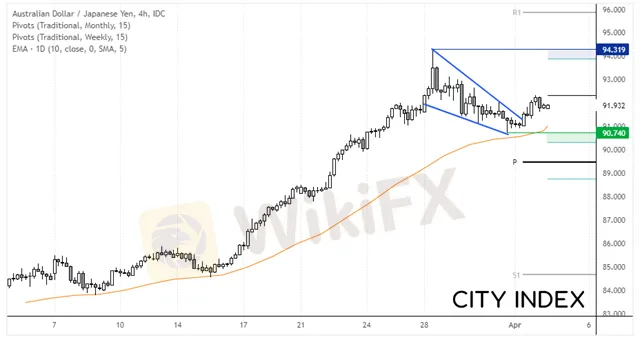简体中文
繁體中文
English
Pусский
日本語
ภาษาไทย
Tiếng Việt
Bahasa Indonesia
Español
हिन्दी
Filippiiniläinen
Français
Deutsch
Português
Türkçe
한국어
العربية
Asian Open: Germany reconsider Russian oil embargo
Abstract:Germany’s defence minister called for fresh discussions with the EU on banning Russian gas imports.
US Friday close:
The Dow Jones rose 139.87 points (0.4%) to close at 34,818.27
The S&P 500 rose 15.45 points (0.35%) to close at 4,545.86
The Nasdaq 100 rose 22.719 points (0.15%) to close at 14,861.21
Asian Indices:
Australias ASX 200 index closed at 7,493.80 on Friday
Japan's Nikkei 225 index closed at 27,665.98 on Friday
Hong Kong's Hang Seng index closed at 22,039.55 on Friday
China'sA50 Index closed at 14,009.59 on Friday
European Friday close:
UK's FTSE 100 index rose 22.22 points (0.3%) to close at 7537.9
Europe's Euro STOXX 50 index rose 16.16 points (0.41%) to close at 3918.68
Germany's DAX index rose 31.73 points (0.22%) to close at 14446.48
France's CAC 40 index rose 24.44 points (0.37%) to close at 6684.31

Wall Street posted minor gains last week after handing back the baulk of their initial gains over on Thursday, before recovering slightly into Fridays close. Bearish hammers formed on the Nasdaq, Dow Jones and S&P 500 on the weekly chart which shows exhaustion at the highs on this timeframe. That we saw a rise in volumes on Thursday yet they had remained below average during the supposed rally raises an alarm for bull. As does the fact the S&P500 failed to hold above 4600 and the Nasdaq failed to hold above 15,000.
Trading exchanges in mainland China and Hong Kong are closed today and tomorrow for the China Meng Festival.
Germany reconsider their stance on oil embargo
Commodities were broadly lower on Friday thanks to ongoing peace talks between Russia and Ukraine. The Thomson Reuters CRB index moved down to a 2-week low, brent futures stopped just shy of falling to $100 whilst brent closed at $99.27. However, we may see a reversal of some of these moves due to the weekend news flows.
Germany began indicating they may be willing to consider banning Russian gas in light of evidence of genocide in Ukraine. Their defence minister called for sanctions on Russia during a televised interview on Sunday, although the Economic Minister raid during a separate interview that whilst Germany was reducing its dependence on Russian oil, it could not wean itself off it right away. Separately, on Friday Germany have also said they may be able to ration power if the standoff continues.
ASX 200:
The ASX 200 rose for a third consecutive week but couldnt quite close the week above 7500, after a 2-day pullback heading into the weekend. It remains a ley level to monitor this week.

ASX 200: 7493.8 (-0.08%), 03 April 2022
Materials (1.33%) was the strongest sector and Telecomms (-1.46%) was the weakest
4 out of the 11 sectors closed higher
7 out of the 11 sectors closed lower
4 out of the 11 sectors outperformed the index
126 (63.00%) stocks advanced, 64 (32.00%) stocks declined
Outperformers:
+15.79% - Lake Resources NL (LKE.AX)
+11.64% - Core Lithium Ltd (CXO.AX)
+8.49% - Allkem Ltd (AKE.AX)
Underperformers:
-5.36% - Perseus Mining Ltd (PRU.AX)
-4.84% - IDP Education Ltd (IEL.AX)
-4.14% - Reece Ltd (REH.AX)
EUR and CHF were the strongest major last week, although it was a volatile ride for bulls and bears and their gains only accounted for around a third of their weekly range. This means trading conditions were also choppy for currencies, along with indices and commodities. USD/JPY hit our 123 target, but only after it pulled back to 121 which was just above our invalidation point. However, a 3-week bullish reversal pattern called a morning star formation has formed.
Quiet calendar in Asia today ahead of RBA tomorrow
The Australian dollar is the strongest major currency so far in 2022. The RBA hold their monetary policy meeting tomorrow and markets have priced in a 30% chance of a hike, down from 36% chance last week. Markets having now priced in a cash rate of 1% by September, with the first hike to come in June, the RBA continue to push back on such an aggressive trajectory with the war in Ukraine adding a “new source of uncertainty” and floods in NSW and VIC are less than ideal. Given the overall strength of the Australian economy and the fact that fear of nuclear war has lessened to that of a month ago we should be on guard for a slightly less dovish
RBA at tomorrows meeting.
Bullish wedge in play on AUD/JPY

AUD/JPY formed a bullish engulfing candle on Friday after finding support at its 10-
day eMA on Thursday. It pulled back around -3.8% from last weeks high to low, so perhaps the corrective low is in place.
We can see on the hourly chart that prices have broken out of a falling wedge pattern, which projects a target at its 94.32 high. Prices are beneath the weekly pivot point so perhaps we‘ll see a pullback today, but as long as it is a low volatility retracement we’re keen to explore bullish setups whilst prices hold above the 10-day eMA (orange line). A break above 92.33 assumes bullish continuation and brings 94 into focus, near the weekly R1 pivot and last weeks high.
Disclaimer:
The views in this article only represent the author's personal views, and do not constitute investment advice on this platform. This platform does not guarantee the accuracy, completeness and timeliness of the information in the article, and will not be liable for any loss caused by the use of or reliance on the information in the article.
Read more

This Economic Indicator Sparks Speculation of a Japan Rate Hike!
The latest data shows that Japan’s base wages in November rose by 2.7% year-on-year, marking the largest increase in 32 years, fueling speculation about a potential BOJ rate hike, but Governor Kazuo Ueda’s dovish remarks in December have shifted market expectations toward a potential delay in policy adjustments.

Rising U.S. Corporate Bankruptcies Deepen Economic Concerns
In 2024, 686 U.S. companies filed for bankruptcy, marking the highest number since 2010.

Turkey Resumes Rate Cuts Amid Easing Inflation
Turkey’s inflation has eased, prompting the central bank to resume interest rate cuts. Striking a balance between economic recovery and inflation control has become a critical focus. However, significant challenges lie ahead, as Turkey continues to navigate complex economic conditions.

New Year, New Surge: Will Oil Prices Keep Rising?
As of the writing of this article (January 2), oil prices stand at $71.88 per barrel. Investors need to continue monitoring whether the supply and demand dynamics will continue to push prices further up.
WikiFX Broker
Latest News
Bitcoin in 2025: The Opportunities and Challenges Ahead
BI Apprehends Japanese Scam Leader in Manila
Join the Event & Level Up Your Forex Journey
Is There Still Opportunity as Gold Reaches 4-Week High?
Bitcoin miner\s claim to recover £600m in Newport tip thrown out
Good News Malaysia: Ready for 5% GDP Growth in 2025!
How to Automate Forex and Crypto Trading for Better Profits
FXCL Lucky Winter Festival Begins
Warning Against MarketsVox
Is the stronger dollar a threat to oil prices?
Currency Calculator






